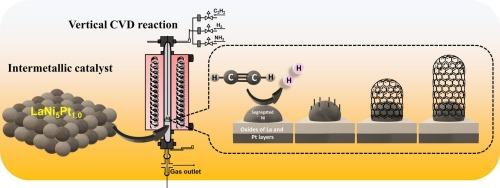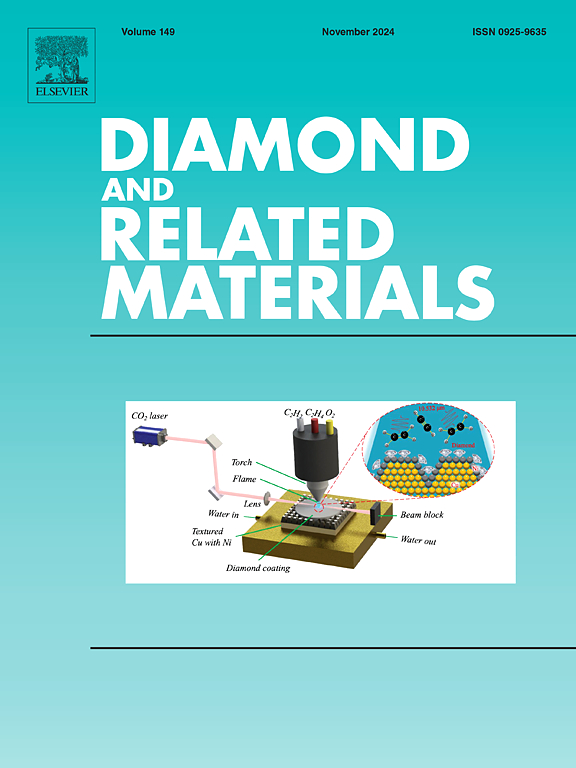通过 LaNi5Pt1.0 金属间催化剂合成的掺氮碳纳米纤维的温度驱动结构和形态变化
IF 4.3
3区 材料科学
Q2 MATERIALS SCIENCE, COATINGS & FILMS
引用次数: 0
摘要
在当今世界,掺杂杂原子的碳同素异形体在基础和应用纳米技术的发展中发挥着举足轻重的作用。由于其优异的电学、热学、化学和机械特性(这些特性受合成方法的影响很大),它们非常适合广泛的应用。催化化学气相沉积(CCVD)是生产具有可控形态和结构特性的掺氮碳纳米纤维(NCNFs)的主要合成技术。本报告强调了反应温度对使用 LaNi5Pt1.0 金属间催化剂合成 CNFs 的重要影响。通过电弧熔化工艺制备的 LaNi5Pt1.0 催化剂可作为模板,通过 CCVD 方法将碳前驱体催化转化为固体材料。此外,本研究还对 NCNFs 合成过程中与温度相关的相变和碳扩散提供了宝贵的见解。驱动催化剂相变的表面偏析机制在 NCNFs 的活性形成过程中起着至关重要的作用。金属镍偏析到 CNF 结构中极大地影响了 N-CNF 的形成,凸显了 CNF 合成过程中错综复杂的动态变化。总之,这些发现加深了人们对不同生长温度下 N-CNF 的合成过程和结构演变的理解。本文章由计算机程序翻译,如有差异,请以英文原文为准。

Temperature-driven structural and morphological changes in nitrogen-doped carbon nanofibers synthesized via LaNi5Pt1.0 intermetallic catalyst
In the modern world, heteroatom-doped carbon allotropes play a pivotal role in both fundamental and applied nanotechnology advancements. Due to their exceptional electrical, thermal, chemical, and mechanical properties, which are strongly influenced by the synthesis method, they are highly suitable for a wide range of applications. Catalytic chemical vapor deposition (CCVD) is the leading synthesis technique for producing nitrogen-doped carbon nanofibers (NCNFs) with controlled morphology and structural properties. This report emphasizes the significant influence of reaction temperature on synthesizing CNFs using a LaNi5Pt1.0 intermetallic catalyst. The LaNi5Pt1.0 catalysts prepared through an arc melting process, acted as templates for the catalytic conversion of carbon precursors into solid material via the CCVD method. Additionally, this study provides valuable insights into the temperature-dependent phase transitions and carbon diffusion during the synthesis of NCNFs. The surface segregation mechanism driving phase changes in the catalyst plays a crucial role in the active formation of NCNFs. The segregation of metallic nickel into the CNF structure significantly impacts N-CNF formation, highlighting the intricate dynamics involved in CNF synthesis. Overall, these findings offer a deeper understanding of the synthesis process and the structural evolution of N-CNFs across different growth temperatures.
求助全文
通过发布文献求助,成功后即可免费获取论文全文。
去求助
来源期刊

Diamond and Related Materials
工程技术-材料科学:综合
CiteScore
6.00
自引率
14.60%
发文量
702
审稿时长
2.1 months
期刊介绍:
DRM is a leading international journal that publishes new fundamental and applied research on all forms of diamond, the integration of diamond with other advanced materials and development of technologies exploiting diamond. The synthesis, characterization and processing of single crystal diamond, polycrystalline films, nanodiamond powders and heterostructures with other advanced materials are encouraged topics for technical and review articles. In addition to diamond, the journal publishes manuscripts on the synthesis, characterization and application of other related materials including diamond-like carbons, carbon nanotubes, graphene, and boron and carbon nitrides. Articles are sought on the chemical functionalization of diamond and related materials as well as their use in electrochemistry, energy storage and conversion, chemical and biological sensing, imaging, thermal management, photonic and quantum applications, electron emission and electronic devices.
The International Conference on Diamond and Carbon Materials has evolved into the largest and most well attended forum in the field of diamond, providing a forum to showcase the latest results in the science and technology of diamond and other carbon materials such as carbon nanotubes, graphene, and diamond-like carbon. Run annually in association with Diamond and Related Materials the conference provides junior and established researchers the opportunity to exchange the latest results ranging from fundamental physical and chemical concepts to applied research focusing on the next generation carbon-based devices.
 求助内容:
求助内容: 应助结果提醒方式:
应助结果提醒方式:


